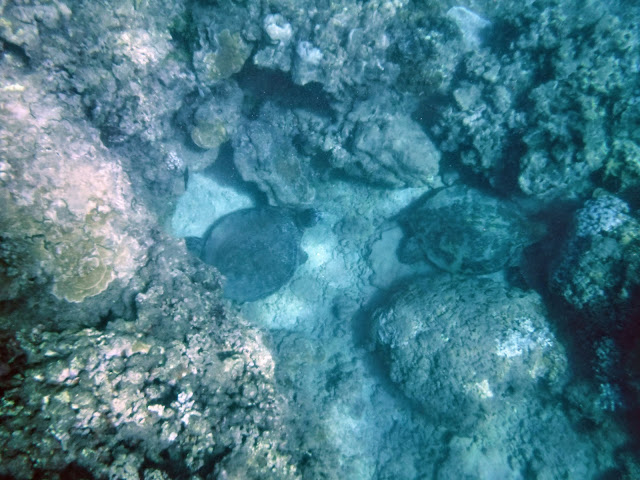Legends fuel many of our dreams and, sometimes, even our actions. The search for a fountain of youth drove Ponce de Leon to explore much of the present-day southeastern United States. To the west, El Dorado, a city of gold, was in the fortune-lusting minds of numerous conquistadors. As for me, just last week, I dreamt of a bay so dense with sea turtles that you could walk across it on the animals' backs.
Honokeana Bay was my destination for the first three days of my latest Maui vacation. It's one of a series of six consecutive bays that figure in the history of Maui, which oral legend recounts was a significant region in Pi'ilani's unification of the island four centuries ago. To connect far-ranging communities, this successful king soon thereafter constructed a long road, a fragment of which still passes each of the coves on Lower Honoapi'ilani - literally in Hawaiian, bays acquired by Pi'ilani - Road.
Besides archaeological artifacts, place names might be the most immediately visible remnants of the old Polynesian culture on the Hawaiian Islands. In fact, Honokeana means cave bay in the Hawaiian language.
In terms of natural history, turtles continue to visit the body of water today as they probably have since before human settlement. I wasn't checked into my apartment for more than a few minutes before I walked to the scenic bay's shoreline a hundred feet away where I spied a couple of turtles sunning themselves in the late afternoon heat. A little while later I observed at least a dozen individuals swimming and dining on sea grass or algae during my quick snorkel in the water.
The next morning I easily spotted another dozen turtles; on my second dip a half hour later, I saw several sleeping on sandy channels under rock and coral ledges. The next day I probably discovered ten, including at least three swimming in a single group, an elegant pas de trois that featured a chorus of goldring surgeonfish feeding off the algae coating the dancers' shells. Finally, on my last morning in the bay, I lost my count again at twelve individuals.
It was easy to lose track of the turtle census because Honokeana Bay is a great spot to see other marine life amidst striking coral formations in placid, clear water. I identified my first bridled triggerfish (a female) and my first lizardfish (I don't know exactly which one of sixteen possible species) among lots of familiar cornetfish, Moorish idols, and reef triggerfish.
I stayed at an apartment in a 38-unit condominium complex, Honokeana Cove, situated in the middle of its namesake bay's rocky beach. There is no easier or safer way to enter the water than from the resort's paved ramp that leads to a couple of flat steps descending to the water at the only sandy seafloor close to the shoreline. To the north of the property is a public path from Lower Honoapi'ilani Road where any visitor or tourist must navigate rough lava before enjoying a swim. I for one preferred the safety if not exclusiveness of Honokeana Cove where another Hawaiian island, Molokai, eight miles away, created a spectacular daytime backdrop.
Encountering green sea turtles is becoming easier and easier thanks to decades of conservation efforts. The species was protected in 1978 under the Endangered Species Act and the results are noticeable today. I can honestly say that's it's rare I snorkel off a beach in Maui without seeing a turtle. And I've never witnessed as high of concentration of the critters as I did in Honokeana Bay.
Unfortunately turtles are easily ensnared in the lines and nets of fishermen. And run-ins with boats and their motors' propellers can harm or kill one of these large reptiles. I saw at least two different turtles missing one of their front flippers. One of these individual's shells was etched with "MA72" in large figures. A little bit of research informed me that the Maui Ocean Center Marine Institute had treated the turtle for "fishing line entanglement." The creature happily survived but with an amputation.
I saw several turtles with signs of Fibropapillomatosis (FP), a disease in the herpes family. First observed in the 1930's in Florida and since then reaching Hawaii, it causes cauliflower-like tumors to grow on a turtle's flesh including its head and flippers. These growths can inhibit a turtle's normal eating, swimming and breathing. For now, however, it appears run-ins with mankind's fishing gear is by far the animal's biggest threat.
Late each afternoon, I regularly counted six turtles lying on the rocks along the shore. At sunset, late day snorkelers enjoyed some final underwater sightings in the colorful twilight. Tiny dots and flat outlines indicated poking heads and cresting shells in the light-dappled water. One, two, three, ... maybe seven or eight turtles at a time - I couldn't scan the wide bay fast enough - took breaths of air. It was sublime at sunrise: an empty, pink-hued bay except for breaching turtles.
Shortly after I checked into the resort, Lynn, a gregarious, long-time guest eagerly showed me the easy pathway into the bay's waters. He told me that the property manager estimated sixty turtles visited Honokeana Bay at any given time. "You mean six-TEEN?" I asked incredulously. "No, sixty," Lynn replied.
Since I kept losing count at a dozen, became chilled after forty-five minutes in the water at a time, and didn't have the strength to swim all the bay's surface area, I had to trust this local's figure over my anecdotal data. So let's see, if each turtle is up to four feet in length, and you spaced them each a yard apart, you have a total span of 720 feet - easily enough distance for a man to walk across Honokeana Bay on the backs of turtles.
By Jove, I just calculated how the legend was born.











Comments
Post a Comment